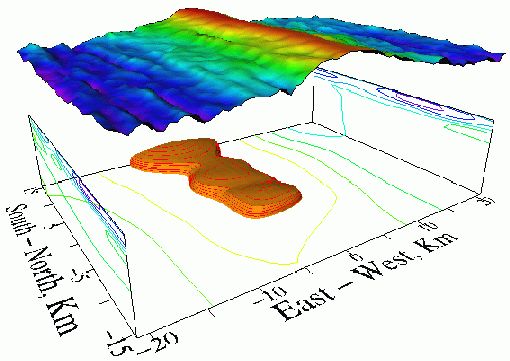
Douglas Toomey, Janice Cuny, Allen Malony, Christopher Harrop and Robert Dunn
Mid-ocean ridges are the primary sites for transferring heat and material from the Earth's interior to its surface. The bulk of the planet's magmatic budget is accounted for by the generation of 20 cubic kilometers of new oceanic crust every year (equivalent to paving 250,000 miles of interstate highway with 3 feet of lava). Central to this exchange of heat and chemicals between the solid earth and the oceans are magma chambers, volumes of molten rock that cap the magma plumbing system and force the circulation of seawater through newly formed crust. To further understand the pivotal role mid-ocean ridge magma chambers play in the chemistry of the oceans and the formation of two-thirds of the planet's surface, marine geophysicists are using tomographic methods to image three- dimensional variations in physical properties kilometers beneath the seafloor (seismic tomography is similar in concept to CAT-scan imaging used in medical applications.).
The accompanying figure shows a tomographic image of a section of the fast-spreading East Pacific Rise at 9° 30'N. This single image is the result of hundreds of analyses. Prior to the Institute, such modeling was impossible because of the enormous amounts of CPU time required on conventional computers. Using the Institute's supercomputers we were able to discover a section of the magma plumbing system that was previously unknown to exist. This result, shown in the image below, helps to improve predictions of the chemistry, timing, and distribution of seafloor eruptions and the evolution of magmatically-driven hydrothermal systems.

The seafloor is shown in the relief map; the ridge axis where new crust is being formed is located at its topographic high. The horizontal and vertical planes are sections through the earth showing regions of anomalous seismic velocities. The horizontal section, taken at a depth of 7 km shows anomalously low velocities (warmer colors), which indicate higher concentrations of molten rock.
For more information on the web, please see http://www.cs.uoregon.edu/~harrop/tierra/
Cuny, J. E., R. Dunn, S. T. Hackstadt, C. Harrop, H. Hersey, A. D. Malony & D. R. Toomey, Building domain-specific environments for computational science: a case study in seismic tomography, Proceedings of the Workshop on Environments and Tools for Parallel Scientific Computing III (1996); to appear International Journal of Supercomputer Applications.
Solomon, S. C. & D. R. Toomey, The structure of mid-ocean ridges, Annu. Rev. Earth Planet. Sci., 20, 329-364, 1992.
Toomey, D. R., G.M. Purdy, S. C. Solomon & W. S. D. Wilcock, The three-dimensional seismic velocity structure of the East Pacific Rise near latitude 9° 30'N, Nature, 347, 639-645, 1990.
Toomey, D. R., S. C. Solomon & G. M. Purdy, Tomographic imaging of the shallow crustal structure of the East Pacific Rise at 9° 30'N, J. Geophys. Res., 99, 24,135-24,157, 1994.